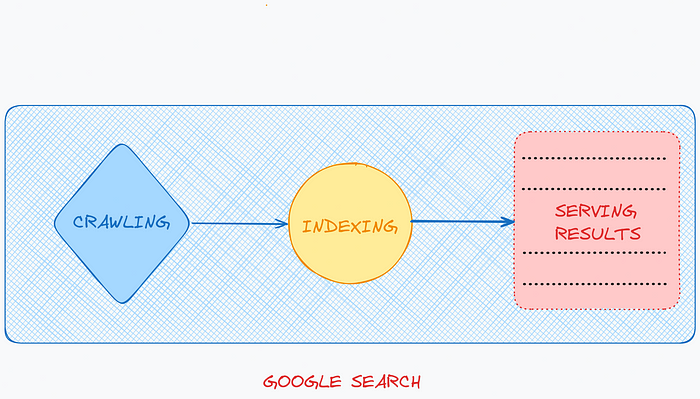How Google Search Works?
 Md Faizan Alam
Md Faizan Alam
Google Search has become an indispensable tool for navigating the vast world of information available online, thanks to sophisticated web crawlers and algorithms such as PageRank. Google Search, which is entirely powered by software, uses web crawlers to continuously explore the web, discovering pages to add to its comprehensive index. This process, which is essential to Google’s ability to serve relevant and reliable search results, moves seamlessly through the crawling, indexing, and serving stages. Googlebot ensures that the most recent content is always available by algorithmically deciding which sites to crawl and how frequently.
In this Article we will explore the fundamental mechanisms that enable Google Search to assess and rank billions of web pages as part of our effort to comprehend how it controls the online information retrieval space.
How Google Crawls and Indexes the Web
Google Search’s ability to navigate the vast expanse of the internet hinges on its sophisticated web crawlers, primarily Googlebot, which play a pivotal role in discovering, indexing, and updating the content found across millions of web pages. This section delves into the intricate processes of crawling and indexing that enable Google Search to provide timely and relevant search results.

Crawling: The Discovery Process
Web Crawlers: Google Search utilizes automated software known as web crawlers to explore the web. Googlebot, the main crawler, functions by visiting web pages to discover content.
Algorithmic Crawling: An algorithmic process determines which sites to crawl, the frequency of crawling, and the number of pages to fetch from each site. This process is designed to avoid overloading websites while ensuring that the content is updated regularly.
Rendering Pages: Googlebot uses a version of Chrome to render pages, allowing it to run JavaScript and properly index dynamic content. This mimics the way a user’s browser would load and view a page.
URL Discovery: The initial step in crawling involves URL discovery, where Googlebot identifies new and updated pages to add to Google’s index.
Indexing: Organizing the Web’s Information
Content Analysis: Once a page is crawled, Google analyzes its content, including text, images, and videos. This information is then stored in the Google index, a vast database that serves as the backbone of the search engine.
Duplicate and Canonical Pages: Googlebot identifies duplicate content and determines the canonical version of a page. This ensures that the most authoritative version is indexed and served in search results.
Sitemaps and robots.txt: Websites can use sitemaps to highlight important pages, ensuring that Googlebot finds and indexes priority content. Additionally, robots.txt files can control which parts of a site are crawled, helping manage the indexing process.
Optimization for Indexing
Google Search Console: This free toolset allows webmasters to optimize how their content is crawled and indexed. It provides insights into how Google views a site and offers suggestions for improvement.
Best Practices for JavaScript: Websites that rely heavily on JavaScript can follow best practices to ensure their content is accessible to Googlebot, enhancing their visibility in search results.
Crawl Budget: Google allocates a crawl budget for each website, which is the number of pages Google will crawl over a certain period. Managing this budget effectively can improve a site’s indexing rate.
Through a combination of algorithmic processes and site optimization tools, Google ensures that its search index remains comprehensive and up-to-date, ultimately facilitating the delivery of relevant and timely search results to users worldwide.
The Google Search Algorithm Explained
Understanding the complexity of Google’s search algorithm requires a deep dive into its core components and how they interact to deliver the most relevant search results. Here, we outline the foundational elements that power Google Search
PageRank Algorithm
Foundation: PageRank is a pivotal Google algorithm, assessing the importance of webpages based on the quality and quantity of links pointing to them.
Evolution: The reasonable surfer patent, filed in June 2004, refined PageRank by recognizing that not all links are equally likely to be clicked. Links in less prominent locations carry less weight, adding a layer of sophistication to the original algorithm.
Current Role: Despite the evolution of Google’s algorithms, PageRank remains a crucial component, underscoring the enduring value of high-quality backlinks.
Ranking System and Factors
Comprehensive Index: Google’s search algorithm compiles the world’s most extensive index, organizing information to be readily accessible.
Sorting Mechanism: Utilizing a ranking system, Google sifts through hundreds of billions of webpages, presenting the most relevant results in mere seconds.
Criteria Considered: The algorithm examines numerous factors, including query words, page relevance and usability, source expertise, along with the user’s location and settings.
Language Models: To match queries with content, Google builds language models that help decipher the intent and relevance of words entered into the search box.
Content Prioritization: Signals are used to identify content that demonstrates expertise, authoritativeness, and trustworthiness, with linking from prominent websites as a key factor.
Usability Factors: Content usability, such as mobile-friendliness and loading speed, also influences the ranking, ensuring a positive user experience.
Algorithmic Updates and Criteria
Dynamic Updates: Google’s algorithm is subject to regular updates, including minor adjustments several times a day and significant core updates several times a year, to improve search quality and relevance.
Ranking Factors: Over 200 specific ranking factors are used, including content organization, website structure, backlinks, domain authority, meta descriptions, keywords in headings, user engagement metrics (click-through rate, bounce rate, dwell time), and more.
Transparency and Integrity: Notably, Google does not accept payment for ranking pages higher, ensuring that search results are determined by relevance and quality alone.
How does Google determine the relevance of search results?
Determining the relevance of search results is a multifaceted process that Google undertakes with the help of a variety of factors and sophisticated algorithms. Here, we break down the key components that Google considers in this process
Understanding User Intent and Query Meaning
Google employs language models to comprehend the intent behind a user’s search query. This involves recognizing spelling mistakes, understanding synonyms, and deducing the type of information the user seeks.
Factors such as the user’s location, past search history, and settings are utilized to tailor search results to what is most relevant for the user at that moment. This customization aims to enhance the relevance and usefulness of search outcomes without inferring sensitive characteristics about the user.
Evaluating Content Relevance and Quality
Google analyzes the content of web pages to assess how well they match the search query. This includes examining keywords, their placement, and the presence of related content beyond the exact keywords.
Google prioritizes content that appears most helpful, identifying signals that indicate expertise, authoritativeness, and trustworthiness. The evaluation includes whether prominent websites link or refer to the content in question.
For queries that demand up-to-date information, the freshness of content plays a critical role in determining its ranking in search results.
Technical and User Experience Factors
Google considers the user experience of webpages, focusing on aspects such as mobile-friendliness and loading speed. These factors contribute to the overall usability and accessibility of content.
Metrics like click-through rate (CTR), bounce rate, and time spent on a page (dwell time) are indicative of user engagement and can influence the ranking of search results.
Websites with secure connections are often prioritized, especially for transactions and sensitive information, to ensure a safe browsing experience for users.
Understanding Google’s PageRank
Understanding the intricacies of Google’s PageRank requires an examination of its foundational principles and operational mechanisms. Here, we dissect the key components that contribute to PageRank’s functionality:
Core Principles of PageRank
Calculation and Recalculation: Google recalculates PageRank scores each time it crawls the web and rebuilds its index, ensuring that the ranking reflects the most current web landscape.
Derived Values: The PageRank of a page is significantly influenced by the PageRank values of other pages that link to it. This interconnectivity underscores the importance of quality backlinks.
Damping Factor: A critical aspect of the calculation involves the damping factor, typically set around 0.85. This factor accounts for the likelihood that a user will continue clicking on links versus starting a new search. The formula subtracts this factor from 1 and adds it to the product of the damping factor and the sum of the incoming PageRank scores, balancing the algorithm.
Operational Mechanism
Probabilistic Approach: At its core, the PageRank of a page represents the probability of arriving at that page after a large number of clicks, simulating a user’s journey through the web.
Influence of Cookies: Google Search’s use of cookies plays a role in enhancing the quality of its services and analyzing traffic, indirectly affecting how PageRank and other algorithms function by providing data on user behavior.
Challenges and Considerations
One of the main disadvantages identified with PageRank is its tendency to favor older pages. This bias can impact the visibility of newer, yet potentially more relevant, content.
The Role of Artificial Intelligence in Google Search

Google has been at the forefront of integrating Artificial Intelligence (AI) into its search engine, revolutionizing how information is processed, understood, and retrieved. Over two decades, Google has developed and harnessed AI to power its core products, significantly enhancing the efficiency and accuracy of Google Search. The role of AI in Google Search can be broadly categorized into the following areas:
AI Language Models and Architecture
Google employs advanced AI language models such as BERT, PALM, MUM, and LaMDA. These models are built on the Transformer architecture, enabling a deeper understanding of the context and nuances within search queries.
The use of these models allows Google to interpret the intent behind users’ searches more accurately, leading to more relevant and contextual search results.
Applications of AI in Google Search
Language Translation: AI enables seamless translation of content across languages, making information accessible globally.
Image and Speech Recognition: These capabilities allow users to search using images and voice commands, broadening the ways in which information can be queried and accessed.
Search Algorithms and Virtual Assistant: AI is integral to refining search algorithms and powering Google’s virtual assistant, ensuring users receive the most relevant answers to their queries.
Email Sorting and Advertising: AI-driven algorithms help in efficiently sorting emails and delivering targeted advertising, enhancing user experience.
Maps/Directions: AI improves navigation and route planning in Google Maps, offering real-time updates and personalized directions.
Enhancing Search Relevance and Understanding
Google’s RankBrain, an AI-powered machine learning algorithm, plays a crucial role in understanding the context and meaning behind search queries. This understanding significantly improves the relevance of search results.
AI-powered features like Featured Snippets and the Knowledge Graph provide quick, relevant information directly in the search results, making it easier for users to find the answers they’re looking for without having to click through to a website.
For voice searches, AI algorithms process spoken language, recognize speech patterns, and provide accurate responses to voice commands in Google Assistant, demonstrating the versatility of AI in understanding and responding to various forms of user queries.
Conclusion
Throughout this exploration, we have unpacked the layers behind Google Search’s unmatched proficiency in sifting through the infinite expanses of the digital realm to fetch*, **index*, and *rank web pages with an astounding level of relevance and speed. From the crawl to the index, each step is critical in shaping the efficiency and accuracy of search results, underpinned by sophisticated algorithms like PageRank and BERT**. These algorithms not only serve as the backbone of Google’s search capabilities but also signify a relentless pursuit of refinement and advancement in handling the complexities of web search. Moreover, understanding the difference between organic and paid search results sheds light on the integral mechanics of online search visibility and the strategic optimization necessary for websites aiming to secure a prominent place in search rankings.*
Thank you for reading! If you have any feedback or notice any mistakes, please feel free to leave a comment below. I’m always looking to improve my writing and value any suggestions you may have. If you’re interested in working together or have any further questions, please don’t hesitate to reach out to me at fa1319673@gmail.com.
Subscribe to my newsletter
Read articles from Md Faizan Alam directly inside your inbox. Subscribe to the newsletter, and don't miss out.
Written by

Md Faizan Alam
Md Faizan Alam
I am a Fullstack Developer from India and a Tech Geek. I try to learn excting new technologies and document my journey in this Blog of mine. I try to spread awareness about new and great technologies I come across or learn.